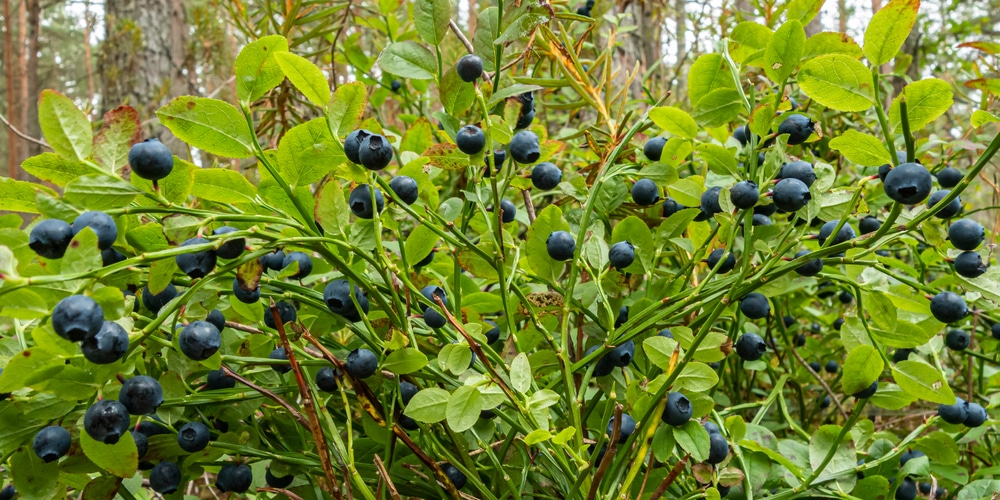Florida’s mild winter season makes growing most deciduous fruits challenging. However, plants like blueberries that have low-chill requirements successfully thrive in the short winter season. Indeed, there are at least eight types of wild blueberries that you can find walking around swamps and rivers.
These delicious and beautiful fruits are native to North America, including Florida. For simplicity, the different species of blueberries you’ll find in Florida can fall into the rabbiteye blueberries and Southern highbush categories. If you are curious about learning how to spot them and identifying the different species, you are in the right spot. In this “Florida Native Blueberry Plants” guide, you’ll find everything you need to know about the varieties of this plant adapted to the living conditions of this state.
Florida Native Blueberry Plants

In the wild, it is easy to confuse blueberries with huckleberries, which are also common plants in Florida. However, you can distinguish the two by looking at the fruit: blueberries have a five-pointed crown at the bottom. Plus, blueberry bushes have long thin branches and broad green leaves. If you are thinking about planting blueberries in your garden, make sure you select a variety that suits your soil and weather conditions.
Both rabbiteye and Southern highbush plants produce similar fruits. However, the first variety includes the “ONeal” and the “Sharpblue” species, which have thicker skins and reach maturity later than highbush berries. These types of berries grow well in the colder parts of Florida.
On the other hand, Southern highbush can adapt well to warmer areas and grow well in soils rich in organic matter. Because of their speed to mature and produce fruits, they are the most popular commercial variety. You may want to know that Southern highbush plants are smaller than rabbiteye: they usually don’t grow more than six feet in height. Plus, this variety includes the Powderblue and Bonitablue species.
Location and Soil Preferences
Both Rabbiteye and Souther highbush thrive in slightly acidic soils and perform better with organic matter. If you are planting them in your yard, consider mulching or incorporating peat moss and pine bark into the soil mixture to increase its nutrient content.
Also, you may want to perform a pH test to ensure the soil conditions are suitable for blueberries to thrive. At pH levels higher than 5.5, you may notice deficient growth. If you need to acidify the soil, you can add some sulfur a couple of months before planting. In general, southern highbush tend to have stricter soil requirements and are more challenging to grow than rabbiteye varieties. They are also more susceptible to diseases. However, they do better in warmer weather.
Florida Native Blueberry plants do best on well-drained soils. Make sure you avoid planting them on sandy soil with poor drainage. Place them in an area that receives plenty of direct sun during the way and prefer somewhere far from roots of trees and building foundations.
Cultivars
Florida Native blueberries have to deal with hot temperatures. The same blueberries that grow in hardiness zone 5 won’t necessarily thrive here.
Choosing the proper location is an essential step. However, selecting the appropriate cultivar is crucial to making your plant thrive. Here you’ll find some of the most popular blueberry species in Florida to help you make up your mind.
Emerald
Common in the north and center of Florida, this plant displays voluminous yields and produces high-quality berries. Its flowers open early in the spring: you can expect its fruits to ripe between April and May.
Jewel
This variety has low chilling requirements, making it an ideal option for most parts of Florida, but especially in the coastal area. Its berries are firmer than other varieties and medium to large. However, you may need to spray some pesticides to prevent early fall defoliation.
Star
This variety thrives in colder winter temperatures and is best suited to north Florida, where it doesn’t display symptoms of inadequate chilling.
Farthing
This tough plant displays a dense canopy and produces large and firm dark berries.
Sweet crisp
Sweet crips have excellent field survival and spread quickly under ideal conditions. The berries are smaller than most of Florida’s cultivars, but it produces exceptionally high-quality berries that seem to last longer after picking than most species.
Beckyblue, Bonita, and Climax
These early-season rabbiteye plants are similar and better adapted to central and southern Florida.
Florida Native Blueberry Plants: Conclusion
You can successfully grow blueberries in your garden in Florida. However, you will have to select the variety that best suits the area you live in.
Related article: Why Your Blueberry Leaves are Turning Red?
